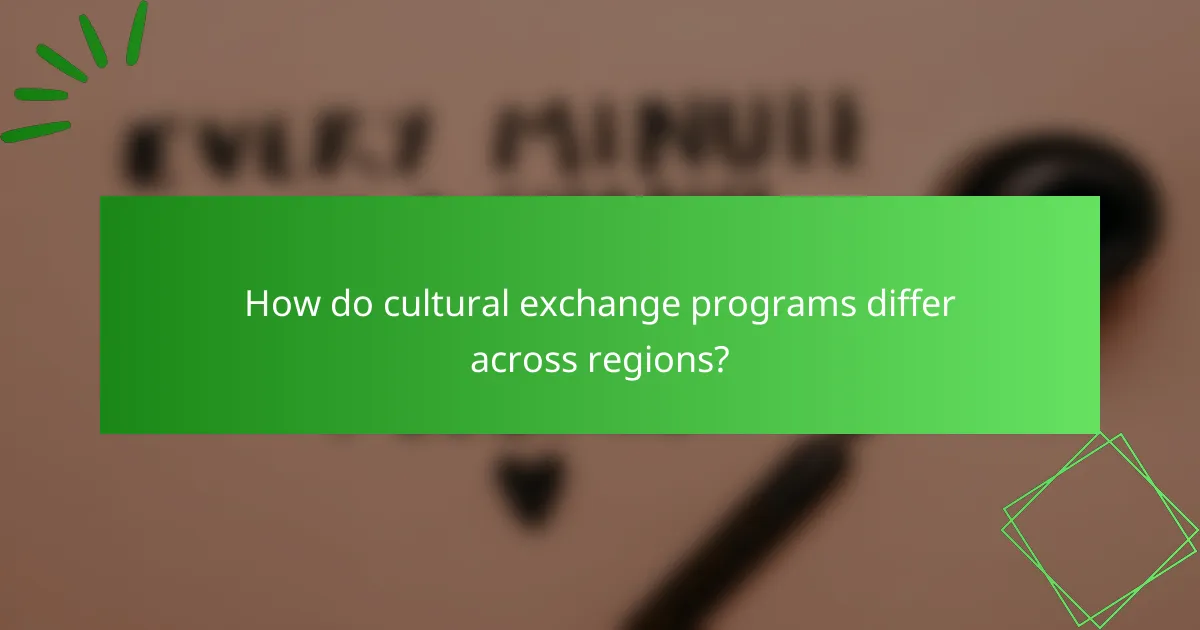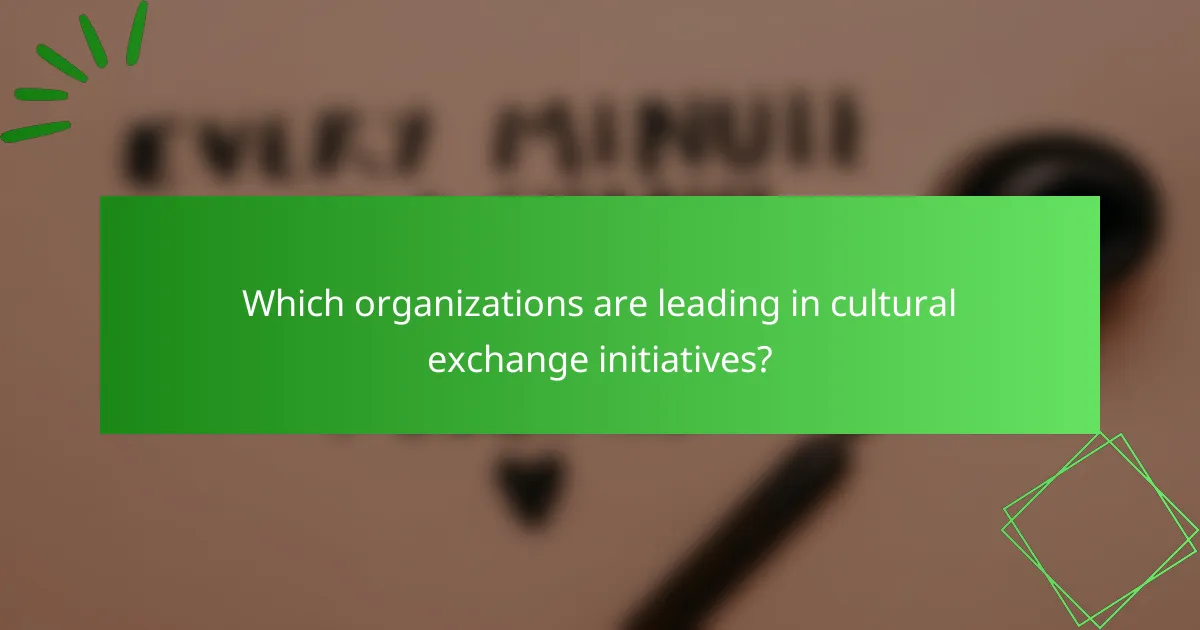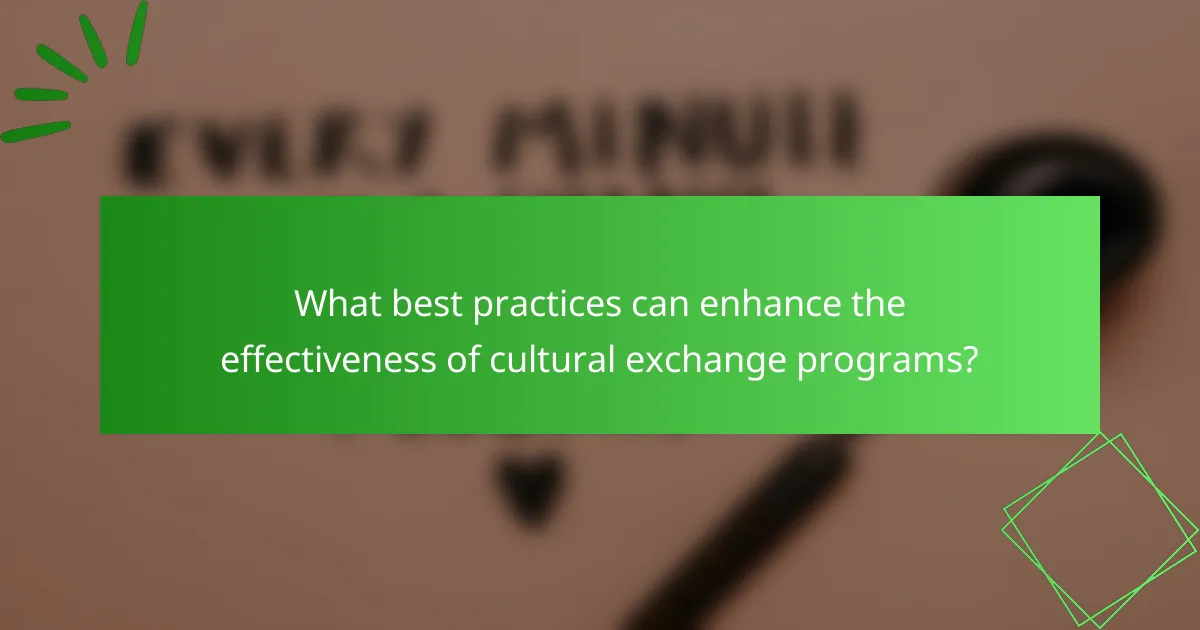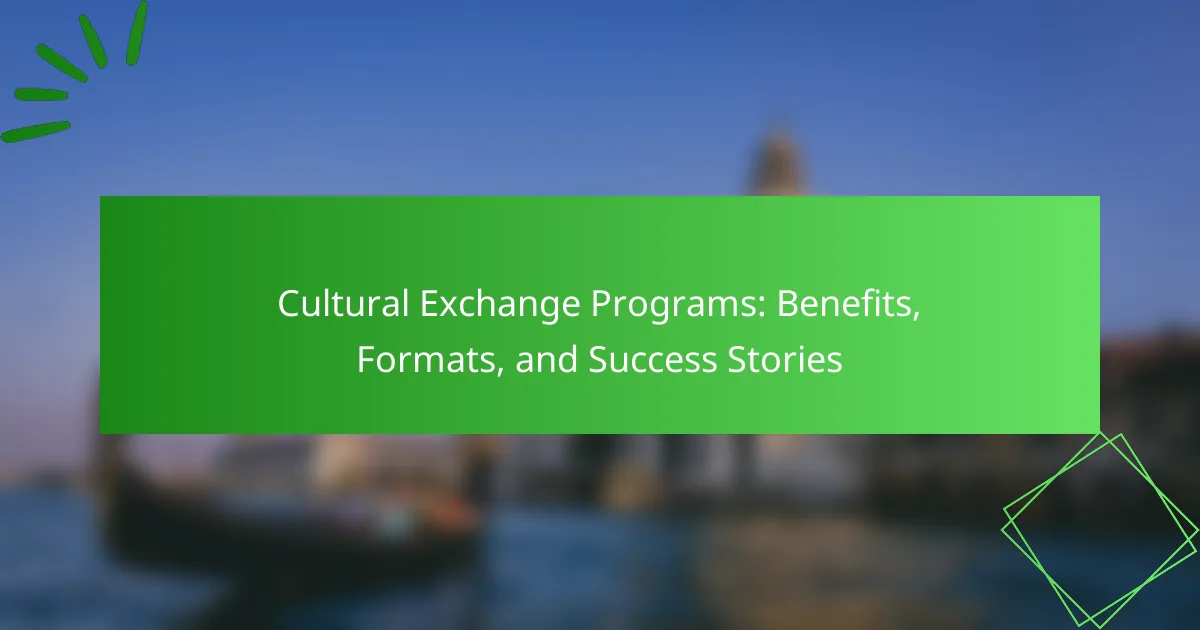Cultural exchange programs provide significant benefits, such as enhanced cultural understanding and improved language skills. They come in various formats, including student exchanges and internships, each promoting personal growth. Success stories from organizations like the Fulbright Program illustrate the transformative impact these initiatives have on global citizenship. However, participants may face challenges that require careful planning and support for a successful experience.

What are the key benefits of cultural exchange programs?
Cultural exchange programs offer numerous benefits, including enhanced cultural understanding, improved language skills, and personal growth. Participants gain firsthand experience of different cultures, fostering empathy and global awareness. These programs also promote professional development by expanding networks and enhancing resumes. As a result, they contribute to community cohesion and international collaboration.
How do cultural exchange programs enhance personal growth?
Cultural exchange programs significantly enhance personal growth by fostering empathy, adaptability, and global awareness. Participants gain firsthand experiences that challenge their perspectives and encourage personal development.
These programs often include immersive activities, such as language learning and cultural workshops, which promote communication skills and intercultural understanding. As a result, individuals become more open-minded and confident in diverse environments.
Success stories from past participants highlight transformative experiences. For instance, many report increased self-awareness and improved problem-solving skills after navigating new cultural contexts.
Overall, cultural exchange programs serve as powerful tools for personal growth, equipping individuals with valuable life skills and a broader worldview.
In what ways do these programs foster global citizenship?
Cultural exchange programs foster global citizenship by promoting understanding, empathy, and collaboration among diverse cultures. Participants gain firsthand experience of different lifestyles, which enhances their global awareness and social responsibility. These programs often include community service components, encouraging active engagement in local issues. As a result, individuals develop skills essential for navigating an interconnected world, such as communication and cultural sensitivity.
What impact do cultural exchange programs have on professional development?
Cultural exchange programs significantly enhance professional development by fostering skills, broadening perspectives, and creating networks. Participants gain intercultural communication skills, adaptability, and global awareness. These attributes boost employability and career advancement. Success stories highlight transformative experiences that lead to innovative solutions in diverse work environments.
How do cultural exchange programs promote cross-cultural understanding?
Cultural exchange programs enhance cross-cultural understanding by fostering direct interaction between diverse groups. Participants gain firsthand experience of different cultures, breaking down stereotypes and promoting empathy. These programs often include language immersion, collaborative projects, and cultural activities that create lasting connections. As a result, they cultivate global citizens who appreciate diversity and foster international cooperation.

What formats do cultural exchange programs typically take?
Cultural exchange programs typically take the form of student exchanges, internships, volunteer opportunities, and cultural immersion experiences. These formats foster global understanding and personal growth. Student exchanges allow participants to attend schools abroad, while internships provide professional experience in different cultural settings. Volunteer opportunities enable individuals to contribute to communities while learning about local customs. Cultural immersion experiences focus on language and daily life, enhancing cultural appreciation. Each format offers unique benefits, promoting cross-cultural connections and personal development.
Which types of cultural exchange programs are most popular?
The most popular types of cultural exchange programs include student exchanges, internships, volunteer programs, and professional exchanges. These formats foster cross-cultural understanding and personal growth.
Student exchanges allow participants to study abroad, enhancing language skills and cultural immersion. Internships provide practical experience in foreign countries, while volunteer programs focus on community service. Professional exchanges facilitate networking and skill development in diverse environments.
How does the duration of cultural exchange programs vary?
The duration of cultural exchange programs varies widely, typically ranging from a few weeks to several months. Short-term programs often last 2-4 weeks, while long-term initiatives can extend from 6 months to a year. Factors influencing duration include program goals, participant age, and host country requirements. For instance, high school exchanges may last an academic year, while professional internships might only be a few months long.
What are the common application processes for cultural exchange programs?
Cultural exchange programs typically involve a structured application process that includes several key steps. Applicants usually begin by researching available programs and identifying their interests. Next, they complete an application form, which often requires personal information, educational background, and motivation statements. Many programs also require letters of recommendation and proof of language proficiency. After submitting the application, candidates may participate in interviews or assessments. Finally, selected applicants receive acceptance notifications and must complete any necessary pre-departure preparations.

How do cultural exchange programs differ across regions?
Cultural exchange programs vary significantly across regions due to differing cultural values, educational systems, and governmental support. For instance, Europe emphasizes language immersion, while Asia often focuses on academic exchange.
In North America, programs are frequently community-based, promoting local engagement. Conversely, in Africa, there is a growing trend towards partnerships that enhance economic development through cultural understanding.
Each region’s unique attributes influence the formats and success stories associated with these programs, showcasing diverse approaches to fostering global connections.
What unique attributes do cultural exchange programs have in North America?
Cultural exchange programs in North America uniquely foster cross-cultural understanding, develop global citizenship, and enhance language skills. They often include immersive experiences, such as homestays and local community engagement. These programs also emphasize diversity by incorporating various cultural perspectives and practices. Additionally, they create networks that support long-term relationships between participants, enriching both personal and professional growth.
How do cultural exchange programs in Europe reflect local customs?
Cultural exchange programs in Europe showcase local customs through immersive experiences. Participants engage with traditions, languages, and community practices, fostering mutual understanding. For instance, programs often include local festivals, culinary classes, and workshops on traditional arts, emphasizing unique cultural attributes. These interactions enhance appreciation for diversity and strengthen international ties.
What are the distinctive features of cultural exchange programs in Asia?
Cultural exchange programs in Asia feature diverse formats, enriching experiences, and strong community ties. These programs often include student exchanges, internships, and cultural workshops. They promote cross-cultural understanding by immersing participants in local traditions, languages, and lifestyles. Success stories highlight transformative impacts on both individuals and communities, fostering global citizenship and collaboration.

What challenges do participants face in cultural exchange programs?
Participants in cultural exchange programs often face challenges such as language barriers, cultural misunderstandings, and homesickness. These issues can hinder effective communication and integration into the host culture. Additionally, logistical challenges like visa processes and financial constraints may arise, impacting the overall experience. As a result, preparation and support systems are crucial for overcoming these obstacles and maximizing the benefits of cultural exchange.
How can participants overcome cultural shock?
Participants can overcome cultural shock through preparation, open-mindedness, and support networks. Engaging in cultural exchange programs fosters adaptability and understanding of diverse perspectives.
Learning about the host culture before arrival helps participants anticipate differences. This knowledge reduces anxiety and enhances integration. Building relationships with locals and fellow participants provides emotional support.
Active participation in cultural activities promotes immersion and appreciation. Sharing experiences with others in similar situations can ease the transition.
Reflecting on personal experiences and maintaining a positive attitude further aids in overcoming challenges. Embracing the journey as a learning opportunity enriches the overall experience.
What are the common logistical issues encountered?
Cultural exchange programs often face logistical issues such as funding constraints, visa challenges, and communication barriers. These factors can disrupt planning and execution, affecting participant experiences. Effective management strategies can mitigate these issues, ensuring smoother operations and successful outcomes.

Which organizations are leading in cultural exchange initiatives?
Several organizations lead in cultural exchange initiatives, including UNESCO, the Fulbright Program, and AFS Intercultural Programs. These entities promote cross-cultural understanding through various formats such as student exchanges, internships, and community engagement projects. Their success stories highlight the positive impact on global citizenship and intercultural dialogue. For instance, the Fulbright Program has facilitated over 390,000 exchanges since its inception, fostering international collaboration and academic growth.
What role do governmental bodies play in cultural exchange programs?
Governmental bodies play a crucial role in cultural exchange programs by facilitating partnerships, funding initiatives, and promoting international collaboration. They establish policies that support cultural diplomacy and provide resources to ensure successful exchanges. These programs enhance mutual understanding and strengthen diplomatic ties between nations. For example, the U.S. State Department funds various cultural exchange initiatives, fostering global connections and cultural appreciation.
How do non-profit organizations facilitate cultural exchanges?
Non-profit organizations facilitate cultural exchanges by creating programs that promote understanding and collaboration among diverse communities. They offer various formats, such as student exchange programs, workshops, and cultural festivals, which enhance cross-cultural communication. These initiatives often lead to lasting relationships and shared experiences that enrich participants’ lives. Success stories, like the Fulbright Program, showcase the profound impact of such exchanges on global perspectives and personal growth.

What are some success stories from cultural exchange programs?
Cultural exchange programs have led to numerous success stories that highlight their transformative impact. Participants often report enhanced cultural understanding, improved language skills, and expanded professional networks.
For example, a student exchange program between the United States and Japan resulted in participants developing lifelong friendships and collaborative projects that bridged cultural gaps. Similarly, a cultural immersion initiative in South America helped participants gain insights into local traditions, fostering appreciation and respect for diversity.
These programs often yield unique outcomes, such as increased empathy and global citizenship among participants, which contributes to a more interconnected world.
How have participants transformed their lives through these programs?
Participants have transformed their lives through cultural exchange programs by gaining new perspectives, enhancing skills, and building lasting relationships. These programs foster personal growth and cultural understanding, leading to increased confidence and adaptability. Success stories highlight individuals who have launched careers or initiated community projects inspired by their experiences abroad. For example, a participant may return with a unique skill set, such as language fluency or intercultural communication abilities, which significantly enhances their employability.
What impact have cultural exchange programs had on communities?
Cultural exchange programs positively impact communities by fostering understanding and collaboration. They enhance social cohesion, promote diversity, and encourage local economic growth. For example, participants often share cultural practices, leading to enriched community experiences. Additionally, these programs can improve language skills and create lasting international friendships, which contribute to global awareness and empathy.
What notable partnerships have emerged from cultural exchange initiatives?
Notable partnerships from cultural exchange initiatives include collaborations between educational institutions, artists, and governments. These partnerships often lead to enhanced cultural understanding and innovative projects. For example, the Fulbright Program fosters academic exchanges, while initiatives like Sister Cities promote local government partnerships. Such collaborations highlight the importance of cultural diplomacy in creating lasting international relationships.

What best practices can enhance the effectiveness of cultural exchange programs?
Cultural exchange programs enhance effectiveness through careful planning, participant selection, and continuous evaluation. Prioritizing clear objectives ensures alignment with cultural goals. Engaging local communities fosters deeper connections and enriches experiences. Providing pre-departure training equips participants with essential cultural insights. Post-program feedback allows for improvements in future iterations.
How can participants maximize their cultural exchange experience?
Participants can maximize their cultural exchange experience by actively engaging with the host culture, building relationships, and embracing new perspectives. Immersing oneself in local traditions and practices enhances learning and personal growth.
Networking with fellow participants and locals fosters meaningful connections, which can lead to lasting friendships and professional opportunities. Setting clear goals for the exchange can help participants focus on specific skills or knowledge they wish to gain.
Being open-minded and adaptable allows individuals to navigate cultural differences effectively, enriching their overall experience. Lastly, documenting experiences through journaling or photography can provide valuable reflections and insights for future endeavors.
What strategies do organizations use to ensure successful outcomes?
Organizations utilize various strategies to ensure successful outcomes in cultural exchange programs. These include thorough planning, clear objectives, and effective communication.
1. Establishing partnerships with local organizations enhances cultural immersion and support.
2. Providing comprehensive training for participants prepares them for cultural nuances.
3. Implementing feedback mechanisms allows for continuous improvement and adaptation.
4. Celebrating success stories fosters motivation and showcases the program’s impact.
5. Utilizing technology for virtual exchanges expands accessibility and reach.
By focusing on these strategies, organizations can maximize the benefits of cultural exchange programs.
What common mistakes should participants avoid in cultural exchange programs?
Participants in cultural exchange programs should avoid several common mistakes. First, failing to research the host culture can lead to misunderstandings. Second, not being open-minded may hinder meaningful interactions. Third, neglecting to communicate effectively can create barriers. Lastly, overlooking the importance of adaptability can limit the overall experience.




